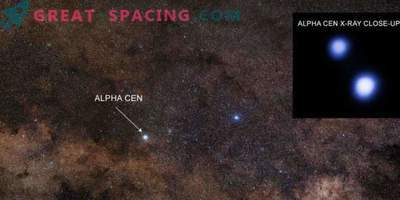
Astronomers are putting forward convincing evidence that a nearby star, probably formed from Alpha Centauri, can seriously affect the habitability of Proxima b (a well-known exoplanet with a size similar to Earth).
After decades of uncertainty, it seems, scientists have found the most significant evidence that Proxima Centauri really is “gravitationally connected” with Alpha Centauri. This is interesting for many reasons. First of all, because now we are sure that the Alpha Centauri system is a triple, with two stars (Alpha Centauri A and B), which revolve closely around a strange sister (Proxima Centauri) with an extremely wide orbit.
But with the recent discovery of a small, rocky exoplanet in orbit, Proxima raises hopes that there can be life on a small world.
Proxima Centauri is located in 4.25 light years, from which it turns into the star closest to us after Sun. Its planet (Proxima b) has an approximate Earth mass and is located within the “habitable zone” - an area around a star whose temperature meets the conditions for the presence of liquid water on the surface. It is always interesting to find any planet in the habitable zone (no matter what size it is), because if there is water there, then there are chances for the development of life. And to open a potentially inhabited world on our galactic threshold is incredible luck. Although we know about the existence of Proxima b, we can only guess about its composition. But new research suggests that Proxima Centauri is a distant sister of Alpha Centauri, which will help clarify the situation.
Proxima Centauri discovered 100 years ago. And since then, astronomers have been trying to understand its movement, and this is a difficult task, considering how dull it is. Red dwarfs are several times smaller and produce only a fraction of the light that the Sun gives. But with the help of a high-precision echelle spectrograph (HARPS), a tool from the La Silla Observatory in Chile, astronomers measured the radial velocity of a dim star for the first time. And this is a key indicator to determine if there is a connection with Alpha Centauri.
The HARPS device is extremely sensitive to the fluctuation of stars and small exoplanets orbiting around them. It was he who discovered the tiny rocking of Proxima Centauri, showing the presence of Proxima b. But this time, HARPS was able to detect the speed at which the tiny star moves away from us, and compare it with the radial velocity of Alpha Centauri. Both radial velocities are similar, which means that they are gravitationally coupled.
Although this is a significant find (scientists have struggled with the mystery of the three stars since the appearance of Proxima Centauri), it can hide the spicy news about the nature of exoplanets. If they are connected by gravity, then we get the key to the fact that this group was formed from the same star-forming nebulae billions of years ago. So, they are all the same age. Over time, their orbits evolved and Proxima Centauri for some reason was thrown out of binary Alpha Centauri. The researchers suggest that, before being in their current position, Proxima Centauri was forming far from the star, and then descended to a lower orbit. When the object was in a distant (and cold) orbit, ice could form on it. And now Proxima b rotates in very favorable conditions allowing life to arise. So maybe there is water on it now.
Although it is too far away for us to assert, it is still interesting to imagine how alien oceans are splashing under the red sun.











































